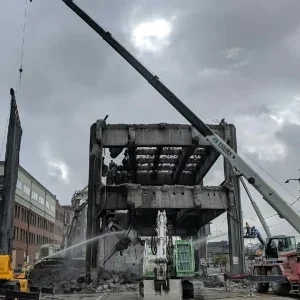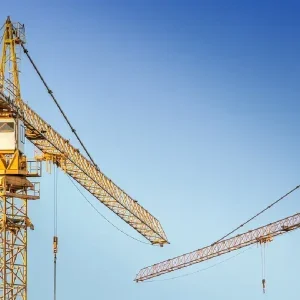
Introduction
The cranes industry, integral to construction, infrastructure, and logistics, is not immune to the effects of economic downturns. These periods of economic decline can significantly impact the demand for construction projects, influence investment decisions, and alter market dynamics. This article explores the challenges posed by economic downturns on the cranes industry and provides strategies to mitigate their impacts. By understanding these factors and implementing adaptive measures, industry players can better navigate economic uncertainties and emerge resilient.
Understanding economic downturns
Definition and causes
An economic downturn refers to a period of reduced economic activity characterized by declining GDP, rising unemployment rates, decreased consumer spending, and lower industrial production. Several factors can trigger economic downturns, including:
- Financial Crises: Bank failures, stock market crashes, and credit shortages can lead to widespread economic instability.
- Global Events: Pandemics, geopolitical tensions, and natural disasters can disrupt economic activities on a global scale.
- Inflation and Deflation: Extreme inflation or deflation can destabilise economies, leading to reduced consumer confidence and spending.
- Policy Changes: Shifts in government policies, such as increased taxes or reduced public spending, can slow economic growth.
Historical context
Historical examples of significant economic downturns include:
- The Great Depression (1929-1939): A severe worldwide economic depression that had profound effects on virtually every economy.
- The Global Financial Crisis (2007-2008): A major financial crisis that resulted in the collapse of financial institutions and significant economic decline globally.
- The COVID-19 Pandemic (2020-Present): An ongoing global health crisis that led to unprecedented economic disruptions due to lockdowns and reduced economic activity.
Impacts on the cranes industry
Reduced demand for construction projects
Economic downturns often lead to reduced investment in construction and infrastructure projects due to:
- Budget Constraints: Governments and private entities may cut back on spending, delaying or cancelling construction projects.
- Investor Uncertainty: Uncertainty about future economic conditions can cause investors to hold back on funding new projects.
- Decreased Property Values: Lower property values can reduce the feasibility of new construction ventures.
Supply chain disruptions
The cranes industry relies heavily on a global supply chain for raw materials, parts, and components. Economic downturns can cause:
- Material Shortages: Disruptions in the supply chain can lead to shortages of essential materials like steel and concrete.
- Increased Costs: Supply chain inefficiencies and transportation issues can drive up costs for materials and equipment.
- Delays in Delivery: Longer lead times and shipping delays can impede project timelines.
Financial challenges
Economic downturns can strain the financial health of companies in the cranes industry through:
- Reduced Revenues: Lower demand for cranes and related services can lead to decreased revenues.
- Cash Flow Issues: Delayed payments and reduced access to credit can create cash flow challenges.
- Credit Constraints: Tighter credit conditions can make it difficult for companies to secure financing for operations and growth.
Workforce reductions
Economic downturns often lead to workforce reductions as companies attempt to cut costs, resulting in:
- Layoffs and Furloughs: Companies may reduce their workforce to manage operating costs.
- Loss of Skilled Labour: Layoffs can result in the loss of skilled and experienced workers, impacting future project capabilities.
- Morale and Productivity: Workforce reductions can negatively affect employee morale and productivity.
Strategies for mitigating the impact
Diversification of services
One effective strategy for mitigating the impacts of economic downturns is diversifying services. Companies in the cranes industry can explore:
- New Markets: Expanding into new geographical markets that are less affected by the downturn.
- Alternative Industries: Providing services to industries less impacted by economic fluctuations, such as renewable energy or public infrastructure projects.
- Maintenance and Repair Services: Offering maintenance and repair services can provide a steady revenue stream even when new construction projects are scarce.
Financial management and cost control
Effective financial management and cost control are crucial during economic downturns. Strategies include:
- Budget Optimization: Revising budgets to prioritise essential expenditures and reduce non-essential costs.
- Cash Flow Management: Implementing measures to improve cash flow, such as more efficient invoicing and better payment terms with suppliers.
- Debt Management: Reducing debt levels and negotiating more favourable terms with lenders.
Strengthening supply chains
Building a resilient supply chain can help mitigate the impact of economic downturns. Key actions include:
- Supplier Diversification: Engaging multiple suppliers to reduce dependency on any single source.
- Inventory Management: Maintaining optimal inventory levels to balance supply and demand effectively.
- Local Sourcing: Where possible, sourcing materials and components locally to reduce reliance on international supply chains.
Investment in technology
Investing in technology can enhance efficiency and reduce costs. Areas of focus include:
- Automation and Robotics: Implementing automation and robotics to streamline operations and reduce labour costs.
- Digital Twins: Using digital twin technology to simulate and optimise crane operations, improving project planning and execution.
- Predictive Maintenance: Utilising predictive maintenance tools to reduce downtime and extend the lifespan of equipment.
Workforce management
Effective workforce management can help maintain productivity and morale during economic downturns. Strategies include:
- Skills Development: Investing in training and development to enhance the skills of the workforce.
- Flexible Work Arrangements: Implementing flexible work arrangements, such as part-time or remote work, to retain valuable employees.
- Employee Engagement: Fostering a positive work environment to maintain morale and productivity.
Case studies and industry best practices
Case study: Liebherr’s resilience during the global financial crisis
Liebherr, a global leader in crane manufacturing, demonstrated resilience during the 2007-2008 financial crisis by:
- Diversifying Its Product Range: Expanding its product range to include cranes for renewable energy projects and other emerging markets.
- Investing in R&D: Continuing to invest in research and development, resulting in innovative and more efficient crane models.
- Strengthening Customer Relationships: Maintaining strong relationships with customers through enhanced support and service offerings.
Best Practice: JLG Industries’ Approach to Cost Control
JLG Industries, a prominent player in the cranes industry, effectively managed costs during the COVID-19 pandemic by:
- Implementing Lean Manufacturing: Adopting lean manufacturing principles to reduce waste and improve efficiency.
- Optimising Supply Chains: Working closely with suppliers to optimise supply chain operations and reduce costs.
- Enhancing Digital Capabilities: Investing in digital tools to improve operational efficiency and customer service.
Future outlook and industry adaptation
Embracing Sustainability
The cranes industry is increasingly recognising the importance of sustainability. During economic downturns, companies can:
- Focus on Green Projects: Targeting projects in renewable energy and sustainable infrastructure.
- Adopt Sustainable Practices: Implementing sustainable practices in manufacturing and operations to reduce environmental impact.
- Leverage Government Incentives: Taking advantage of government incentives for green projects and sustainable practices.
Leveraging Data Analytics
Data analytics can provide valuable insights for decision-making and efficiency improvements. Key applications include:
- Market Analysis: Using data analytics to identify emerging trends and opportunities in the market.
- Operational Optimisation: Analysing operational data to identify areas for improvement and cost reduction.
- Customer Insights: Gaining insights into customer needs and preferences to tailor services and enhance satisfaction.
Preparing for Future Economic Cycles
Economic downturns are cyclical, and preparing for future downturns is crucial. Strategies include:
- Building Financial Reserves: Maintaining a financial buffer to weather economic uncertainties.
- Developing Contingency Plans: Creating comprehensive contingency plans for various economic scenarios.
- Fostering Agility: Building a flexible and agile organisation that can quickly adapt to changing economic conditions.
Conclusion
Economic downturns present significant challenges for the cranes industry, impacting demand, supply chains, financial health, and workforce stability. However, by implementing strategic measures such as diversifying services, enhancing financial management, strengthening supply chains, investing in technology, and effective workforce management, companies can navigate these challenges and emerge stronger. The path to resilience lies in adaptability, innovation, and proactive planning. By embracing sustainability, leveraging data analytics, and preparing for future economic cycles, the cranes industry can not only survive economic downturns but also position itself for long-term success and growth. Through a combination of strategic foresight and operational excellence, the cranes industry can continue to play a vital role in global construction and infrastructure development, even in the face of economic uncertainties.






